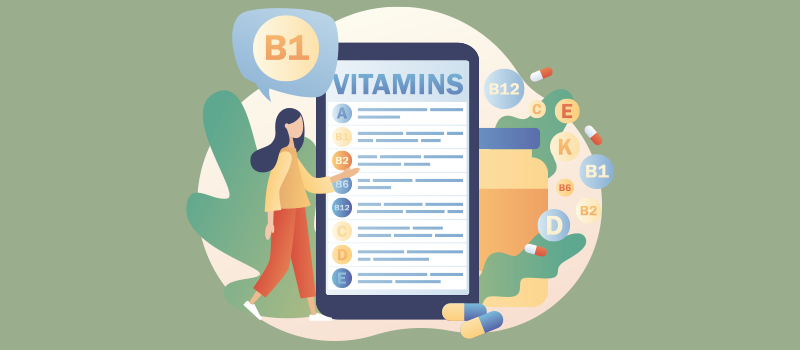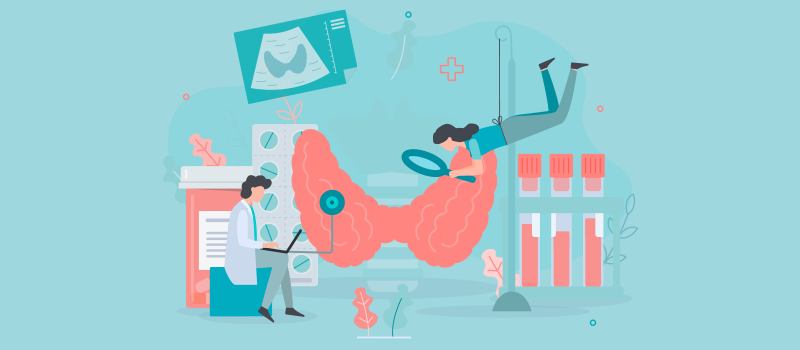What’s the Buzz
The Bee Healthy Blog
Hypoparathyroidism: Symptoms, Causes, & Treatments

Key Takeaways
-
Hypoparathyroidism is a condition in which there are low levels of parathyroid hormone (PTH) in the body. Common causes include some autoimmune disorders or injury to the parathyroid glands during a thyroid gland procedure or neck surgery.
-
Some symptoms of hypoparathyroidism include tingling sensations, muscle cramps, stomach pain, abnormal heart rate, cataracts, dry skin and hair, brittle nails, thinned tooth enamel, and abnormal teeth.
-
While there are some treatment options for hypoparathyroidism, the typical regimen will include restoring mineral levels to the normal range with oral calcium and vitamin D daily for life.
Hypoparathyroidism is a condition in which there are low levels of parathyroid hormone (PTH) in the body. This hormone is produced by the parathyroid glands in the neck, and it regulates calcium and phosphorus levels in the body.
Please continue reading to learn more about the causes and symptoms of hypoparathyroidism as well as treatment options for this condition.
Where are the parathyroid glands?
The parathyroid glands are a group of four small endocrine glands located behind the thyroid gland in the neck. They produce the parathyroid hormone (PTH).
Hypoparathyroidism occurs when the parathyroid glands don’t work properly, leading to low levels of parathyroid hormone in the body.
What does the parathyroid hormone do?
Parathyroid hormone (PTH) plays a vital role in regulating calcium and phosphorus levels in the body. Additionally, PTH also helps control the levels of vitamin D in the blood.
Therefore, when there isn’t enough parathyroid hormone, it can lead to abnormal levels of these essential minerals. Specifically, hypoparathyroidism causes low calcium levels and high phosphorus levels in the blood.
This can cause health problems such as changes in the bones, poor physical growth, slowed mental development, and abnormal teeth.
Hypoparathyroidism is also associated with an increased risk of illnesses such as high blood pressure, Addison’s disease, pernicious anemia, Parkinson’s disease, and cataracts.
What is the most common cause of hypoparathyroidism?
The most common cause of hypoparathyroidism is injury to the parathyroid glands during a thyroid gland procedure or neck surgery.
Other less common causes include autoimmune conditions involving the parathyroid glands, severe hypomagnesemia (very low blood magnesium levels), and radioactive iodine treatment for hyperthyroidism (overactive thyroid). Learn the differences between an underactive vs an overactive thyroid.
Rarely, hypoparathyroidism occurs when the parathyroid glands are absent since birth. This is seen in a genetic condition called DiGeorge syndrome in which a part of chromosome 22 is missing. People with DiGeorge syndrome have other health problems in addition to hypoparathyroidism, such as cardiac abnormalities.
How do I know if I have hypoparathyroidism?
Hypoparathyroidism tends to develop slowly. You may have mild symptoms for many years before you are diagnosed with this condition.
Symptoms of hypoparathyroidism include tingling sensations in the fingers, toes, and lips, muscle cramps, tetany (muscle spasms that can cause breathing difficulties when they affect the throat), stomach pain, pain in the face, arms, and legs, abnormal heart rhythm, cataracts in the eyes, dry, scaly skin, dry hair, brittle nails, pain during menstruation, calcium deposits in body tissues, thinned tooth enamel in children, and abnormal teeth development or absent teeth.
Here’s 8 signs you may have a thyroid condition.
How do doctors make a diagnosis of hypoparathyroidism?
Hypoparathyroidism is often discovered when doctors notice low calcium levels on routine blood tests. This can prompt further investigations, including a physical exam and laboratory tests such as a blood PTH level, magnesium level, calcium and phosphorus levels, and 24-hour urinary calcium excretion.
Your provider may also order other tests, such as an electrocardiogram to detect abnormal heart rhythms and a CT (computed tomography) scan to check for the presence of calcium deposits in the brain.
Can hypoparathyroidism be treated?
Hypoparathyroidism can be treated. The goal of treatment for hypoparathyroidism is to restore mineral levels to the normal range. Hypoparathyroidism treatment would typically include:
-
Taking calcium carbonate and vitamin D supplements to correct low calcium levels. Not only is vitamin D necessary for calcium absorption, but it also helps to eliminate phosphorus, which is elevated with hypoparathyroidism.
-
A high-calcium, low-phosphorus diet is also recommended for the treatment of hypoparathyroidism. Talk to your doctor or a registered dietitian for guidance.
-
Injections of parathyroid hormone may be recommended if oral calcium and vitamin D are not enough to treat your hypoparathyroidism. The U.S. Food and Drug Administration approved Natpara to treat low blood calcium in people with hypoparathyroidism.
-
A magnesium supplement may be recommended if your magnesium level is low and you experience symptoms such as headache, tingling or numbness in your hands and legs, fatigue, and weakness.
-
Thiazide diuretics (water pills) such as hydrochlorothiazide and chlorthalidone may be beneficial in cases where blood calcium levels are still low but urine calcium is high. This type of water pill can help increase blood calcium levels by reducing the amount of calcium secreted in the urine.
How do I know if my PTH levels are improving?
Blood levels of calcium and phosphorus must be monitored more regularly during the early phase of hypoparathyroidism treatment. Your doctor may start with weekly blood tests, which then transition to monthly, then eventually, twice a year once your PTH levels are controlled.
Overcorrection with calcium and vitamin D can lead to hypercalcemia (high blood calcium levels), hyperuricemia (high urine calcium levels), and deposition of calcium in the kidneys and other organs. This can lead to complications such as reduced kidney function and even kidney failure.
That’s why frequent blood tests in the beginning are extremely important so your doctor can adjust your calcium dosage to ensure your blood calcium levels are within normal range.
Very low blood calcium levels in people with hypoparathyroidism can be life-threatening. A person with an acute illness may require treatment with intravenous calcium.
This needs to be done with great care to prevent heart rhythm abnormalities and seizures and to treat throat muscle spasms (laryngeal spasms). Once the acute attack is over, it’s possible to go back to taking oral medicine.
Symptoms of hypoparathyroidism can be managed with oral calcium and vitamin D supplements. In some cases, hypoparathyroidism is temporary, but it can be life-long for many people.
In addition to making changes to your diet, taking medications regularly and getting blood work done as instructed by your doctor are crucial to keeping this condition under control and preventing complications.
What is the difference between hypothyroidism and hypoparathyroidism?
Hypothyroidism is a condition in which the thyroid gland does not make enough thyroid hormones. It is also called underactive thyroid. Common symptoms include fatigue, weakness, dry skin, constipation, weight gain, and depression. (Learn about hypothyroidism vs hyperthyroidism.)
As described above, hypoparathyroidism is a condition in which the parathyroid glands do not make enough parathyroid hormone.
Some of the symptoms of hypoparathyroidism and hypothyroidism are similar and tend to get worse over time.
The causes of the two conditions can also be related. For example, DiGeorge syndrome or autoimmune conditions that cause damage to the endocrine glands, can result in both hypoparathyroidism and hypothyroidism. However, you need a thorough diagnostic evaluation by a physician to find out if you have hypoparathyroidism, hypothyroidism, or both.
Save on Your Medication with BuzzRx!
Manage your medication costs with BuzzRx coupons. Here are direct links to substantial savings for each medication:
Remember, these coupons are widely accepted at over 60,000 pharmacies, including major chains like CVS, Walgreens, and Rite Aid. Just present your coupon at the pharmacy to ensure you're getting the best possible price.
References:












SOCIAL